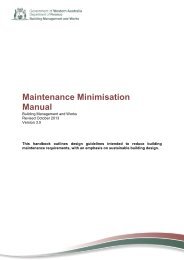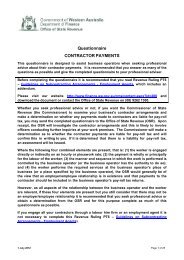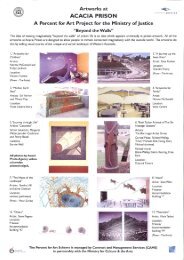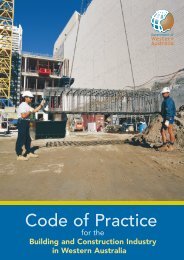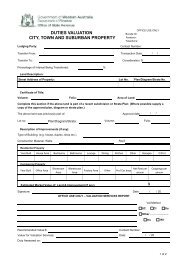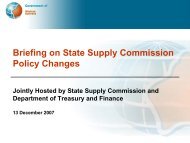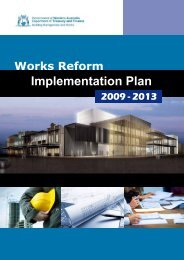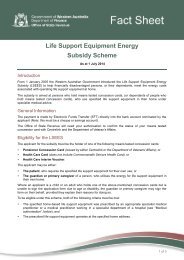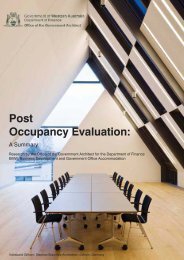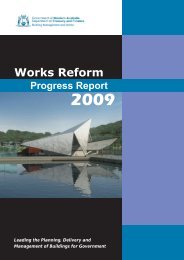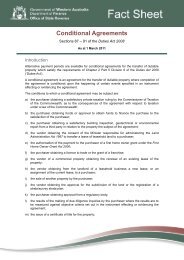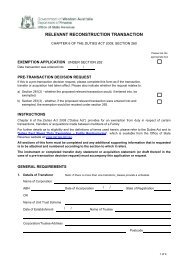Renewable Energy Handbook 2010 - Department of Finance - The ...
Renewable Energy Handbook 2010 - Department of Finance - The ...
Renewable Energy Handbook 2010 - Department of Finance - The ...
Create successful ePaper yourself
Turn your PDF publications into a flip-book with our unique Google optimized e-Paper software.
A 1.1.4 SPECIFIC CONSIDERATIONSWind speed varies considerably with height aboveground, and is affected by local environmentalconditions. Practical wind turbines are designed towork between certain wind speeds. <strong>The</strong> lower speed,called the ‘cut in speed’, is generally 4-5m per secondas there is insuffi cient energy below this speed toovercome system losses.OFFICE OF ENERGYRENEWABLE ENERGY HANDBOOK <strong>2010</strong>47RENEWABLE ENERGY BACKGROUNDRENEWABLE ENERGY ATLAS OF AUSTRALIA:Mean Wind Speed at 80m above ground levelDarwinBrisbaneMetres per Second5.65.86.06.16.26.36.46.56.66.76.97.07.27.810Figure 10.Mean Wind Speedat 80m aboveground level.SOURCE:RENEWABLE ENERGYATLAS, DEPARTMENTENVIRONMENT, WATER,HERITAGE AND THE ARTS.Perthwww.environment.gov.au/renewable/atlas0 250 500 1,000KilometresAdelaideSydneyCanberraMelbourneHobartData Sources:Capital Cities© Commonwealth <strong>of</strong> Australia (<strong>Department</strong><strong>of</strong> the Environment, Water, Heritage andthe Arts) 2008State Borders© Commonwealth <strong>of</strong> Australia (GeoscienceAustralia) 2008Wind Speed© Windlab Systems Pty Ltd 2007Caveat:All data are presumed to be correct asreceived from data providers. Noresponsiblility is taken by theCommonwealth for errors or omissions.<strong>The</strong> Commonwealth does not acceptresponsibility in respect to anyinformation or advice given in relationto, or as a consequence <strong>of</strong> anythingcontained herein.Map produced by:Environmental Resources InformationNewtork (ERIN), <strong>Department</strong> <strong>of</strong> theEnvironment, Water, Heritage and theArts, October 2008.Albers Equal-Area Projection (GDA94)Another consideration is that much <strong>of</strong> rural WesternAustralia has limited capacity power lines that arenot suitable for commercial, utility-scale wind farmswithout an upgrade.Wind turbines can also present challenges for systemmanagement especially during low load periodsovernight, which are characteristic <strong>of</strong> the South WestInterconnected System. As load reduces in the evening,generation plants would normally be taken out <strong>of</strong>service to be restarted as load rises the followingmorning. Only the minimum required plant continuesoperation overnight – typically the most costefficient plant to run, but <strong>of</strong>ten also the least fl exible.Wind generators, which have very low operating costs,effectively compete with those generators that wouldotherwise have operated over this period.Complicating the management <strong>of</strong> low overnight loadsis the fact that conventional generators have a minimumoutput below which they cannot maintain stableoperation and that wind turbines require a level <strong>of</strong>conventional generation support to securely managethe variability <strong>of</strong> wind generator output on the electricitysystem. Together these factors can require the operation<strong>of</strong> a more costly fl exible plant overnight to support windgeneration and the overnight shutdown <strong>of</strong> a minimum costplant that would otherwise have operated continuously.Finding a technically secure and economically effi cientresponse to this challenge is a matter receiving closeattention both here in WA and elsewhere in the world,as the contribution <strong>of</strong> wind generation grows.<strong>The</strong> North Country Reinforcement project (NCR) willcontribute to addressing this issue. <strong>The</strong> NCR consists<strong>of</strong> a 330 kilovolt transmission line from the Pinjarsubstation, just north <strong>of</strong> Perth, to a new terminalat Moonyoonooka, just outside Geraldton. <strong>The</strong>re area number <strong>of</strong> wind farms proposed for the Mid WestRegion and the NCR Project may allow some <strong>of</strong> theseto proceed. In July 2009, Stage One <strong>of</strong> the NCRproject was approved extending the 330 kilovoltpower transmission line from Pinjar to Eneabba.



